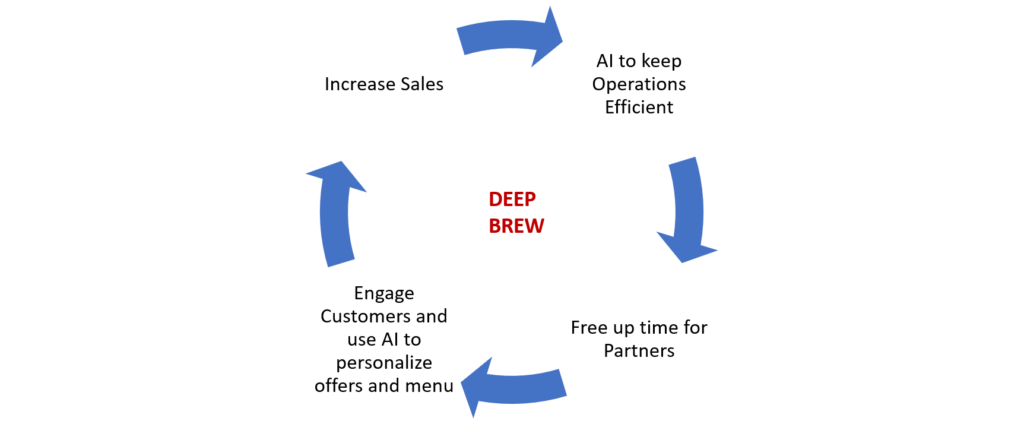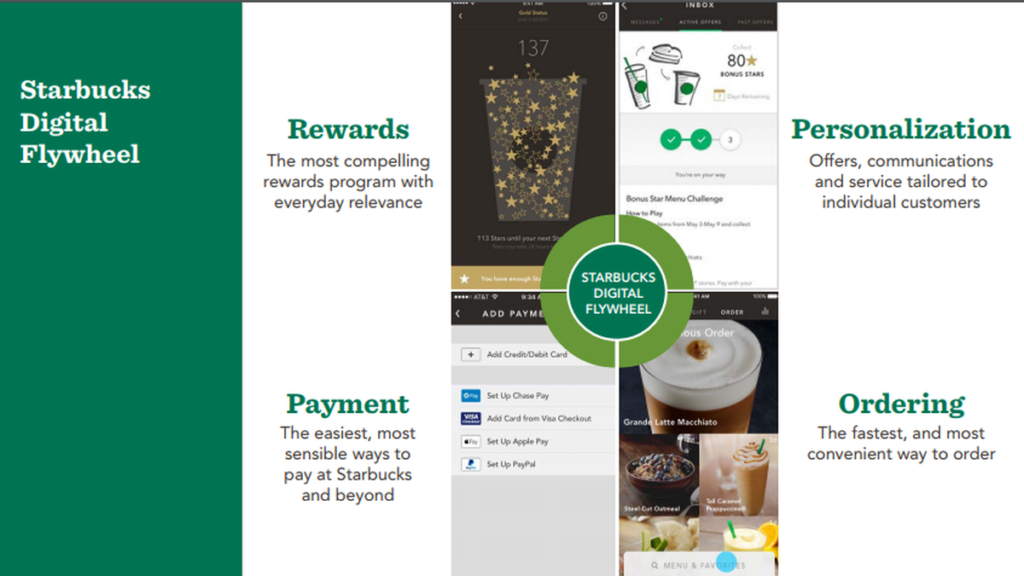Brewing with a dash of Data and Analytics – Starbucks

Starbucks rides on DeepBrew (AI based tools) to keep operations efficient, free up time for partners, engage customers, and improve sales
Starbucks is not short on data. It has over 30,000 stores worldwide and completes close to 100 million transactions per week. The CEO Kevin Johnson spent more than three decades in the tech industry before joining Starbucks (16 years at Microsoft and five as CEO of Juniper Networks). No wonder the company has been at the forefront of applying data and analytics to create and capture value for customers and partners while making its operations efficient. Starbucks had a stellar year in 2019. It was already the third-largest restaurant chain in the world, but even at that size, it managed to add 1,900 locations in fiscal 2019 for 7% unit growth. How?
The recent success in 2019 is a result of “Deep Brew” – a set of AI initiatives across the company. Figure below summarizes the implications:

There are three main entities where the value is created and captured:
Operations
New Starbucks Locations are carefully chosen after analyzing reams of data. The A.I. support for store planning models economic factors about a location. These include population, income levels, traffic, competitor presence, and so on. It uses this to forecast revenues, profits, and other aspects of economic performance. Location based analytics using GIS technology are applied in deciding a new location. This allows Starbucks to minimize the effect of cannibalization and ensure that a new store is able to capture the critical mass of customers that flow through certain areas. This careful planning of new outlets stands in stark contrast with competitor Luckin Coffee (NASDAQ:LK), whose store count has more than tripled to 2,963 stores in 2019 versus the prior year in an apparently haphazard attempt to capture as much market share as possible. All this results in an improved sales performance for its products overall.
Customers

For customers, the Digital Flywheel program creates tremendous value and helps the firm in capturing the value. There were almost 19 million loyalty program users in early 2020. Knowing individual customer order preferences and buying patterns allows Starbucks to provide a “radically personalized” and warm experience. Using AI in the Starbucks app or on the drive-thru menu can present customers with thoughtful, personalized choices based on their own preferences, but also on things like weather and time of day. With the explosive popularity of mobile ordering and delivery services, Starbucks is looking at how AI can help baristas make beverages in an order that takes the whole picture into account. For instance, if a store gets a digital order for four iced lattes but the customer is still 10 miles away, baristas might make other drinks first.
In addition, Starbucks utilized data arising from buying habits across large customer base and across different channels (supermarket data). This gave the firm a strong basis for deciding which products to target the home drinker, and how to dynamically change menu items to delight customers. However, this might over-complicate things and could be tricky to scale.
Partners
Starbucks average bill is relatively a small amount, and hence maintaining a good customer throughput is critical to a store’s success. If a machine breaks down, it can significantly disrupt operations. Conventional approaches would need partners to collect data about machine parameters, repairs required, and so on. This would eat up their valuable time which could have been spent with customers for better service. AI can help in forecasting failures and maintenance needs. A tangible example of where this technology is being used is through a new range of Mastrena super-automatic espresso machines. The machines are equipped with sensors so every shot of espresso is logged and analysed centrally to assess potential areas for tuning and maintenance. This Internet of Things (IoT) technology is combined with Deep Brew to give a prediction of which machines need maintenance when.
Deep Brew will further drive Starbucks’ personalization engine, help optimize store labor allocations, and help manage inventory within the stores. These objectives, if achieved, would free up time for staff to actively connect with customers and provide that important personal touch.
The chain’s mission statement is to “inspire and nurture the human spirit,” and if that’s what customers connect with, then anything the company does to cultivate that makes perfect sense. Deep Brew is a fine example of leveraging AI and Analytics to improve efficiency and provide a more human interaction to create great customer experiences.
Challenges
One of the challenges for the brand would be to provide consistent experience at scale across all its stores globally. Cultures differ widely across regions, and some customers may prefer a socially distant experience. The tools and systems might not work as intended due to technology adoption issues. How can they effectively scale the “Deep Brew” outcomes across the world while providing some level of consistency and incorporating the local context? Hopefully, local AI teams can translate the mission into delightful experiences driven by analytics. Starbucks could be the “data company” that can lead by example across the industry!
References:
https://www.fool.com/investing/2019/12/04/starbucks-knows-how-keep-customers-coming-back.aspx
https://www.fool.com/investing/2019/11/08/how-starbucks-brewing-up-artificial-intelligence.aspx
https://www.pymnts.com/earnings/2020/starbucks-mobile-app-users-now-drive-17-pct-of-sales/



Thanks for the great article. I had no idea that AI could find a place in the world of coffee. Proof that AI will eventually become our digital overlords. AI is certainly a great application for new locations and operations, but I wonder what impact it will have on customer preferences. Is AI really solving a problem for a customer that consistently orders a Chai Latte, three dashes of cinnamon, 1% skimmed milk with foam not to exceed .35 inches? In all seriousness, I’d love to see whether catering to preferences that are already very habitual will offer any real value to the customer, or worse, will it turn them away because the experience seems too invasive? Personally, if a chain coffee company started to do this, I would make a concerted effort to find somewhere local. Giving up that sort of information for a cup of coffee is not worth it to me.
Great point Nicholas, and that’s whats been partially happening at least in Seattle. For example, coffee connoisseurs such as you don’t like the standardization and AI piece. They want a local experience and great coffee. That’s a customer segment that will be very tricky to address at scale. However, if you habitually order the same thing, the app can easily figure it out and make the process more convenient. Will you really like that? Will you really like someone talking to you while you order or just have it delivered without any conversation? All these questions will have different answers in different regions and would be hard to do it with machines.
This a great example of a traditional business has incorporated data analytics to improve their operations and stay ahead of competitors. This is especially important in an industry where competition is so rampant and users have very specific tastes. By developing comprehensive customer profiles they can build strong relationships with their customers and help in retaining these customers. Also by leveraging data to decide on locations and menus this can help lower customer acquisition costs.
It is interesting to see AI enter a space like coffee, and I wonder what the implications are for other quick-serve format businesses like fast food. Will McDonald’s, Yum, and others apply similar learnings to their operations? Additionally, does this leave an open space for robotic alignment with Starbucks where the IoT is taken to the next level and Starbucks machines are placed throughout areas where the service / in-person interaction is less relevant? Does this dilute the Starbucks brand? Some start-up coffee companies are experimenting with models that leverage AI to determine optimal store / station placements, and leaner mechanisms can drive a profitability advantage if Starbucks does not address this gap. In the meantime, it will also be interesting to see how AI-training and implementation impact the talent redemption efforts as baristas may require training, and high turnover could break the flywheel. May require some broader cultural shifts at Starbucks to optimize effectiveness.